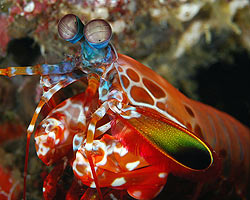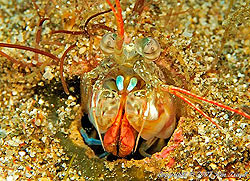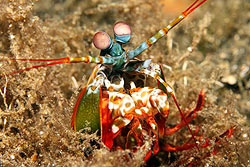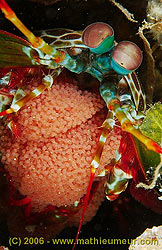Crustaceans
| Decapods - Stomatopods (Mantis Shrimp) |
|
Mantis shrimp (scientific name: Stomatopods) are another group of marine crustaceans that live in the shallow waters of tropical and subtropical seas. There are about 400 species of mantis shrimp which come in a wide range of colours, from shades of browns to bright neon colours.
They are divided into two groups determined by the shape of their claws:
- Spearers are armed with spiny claws with barbed tips which are used to stab and hold soft-bodied prey like fishes and shrimps;
- Smashers have a much better developed club and a simpler spear, the club is used to hit and smash their, like prey, crabs, clams, and snails, apart.
They usually grow to up to 30 centimetres in length. Mantis shrimp are predators and can kill prey much larger than them- the force of the strike of a large Californian species is capable of breaking double layered safety glass. |

|
| |
|
The spearers are in usually larger and less aggressive than the smashers, and they tend to build their burrows in soft materials like mud and sand. The smashers live mainly in hard materials such as corals and rocks and will often immobilize their prey before dragging it back to their home to eat.
They spend most of their time in their homes only leaving to feed or to move into a new home. The mantis shrimps are considered to have the world's most sophisticated vision. Their eye contains 16 different types of photoreceptors (12 for colour analysis, compared to a human's 3 cones), colour filters and many polarisation receptors, making it by far the world's most complex retina. Mantis shrimps can see polarized light and 4 colors of ultraviolet light, and they may also be able to distinguish up to 100,000 colors (compared to the 10,000 seen by humans).
|

|
| |
|
Mantis shrimp are long-lived and show complex behaviours, such as ritualised fighting. Some species use fluorescent patterns on their bodies for signalling to others and maybe even to other species. Many have developed complex social behaviour to defend their space from rivals.
Durint their life they may breed from 20 to 30 times. Depending on the species, the eggs can be laid and kept in a burrow, or carried around under the female's tail until they hatch. Also a male and female may come together only to mate, or they may emain with the same partner for up to 20 years. The hatched eggs may spend up to three months as plankton.
References
http://en.wikipedia.org/wiki/Mantis_shrimp
www.blueboard.com/mantis/ |


|
Next: ... Euphausiids |
|